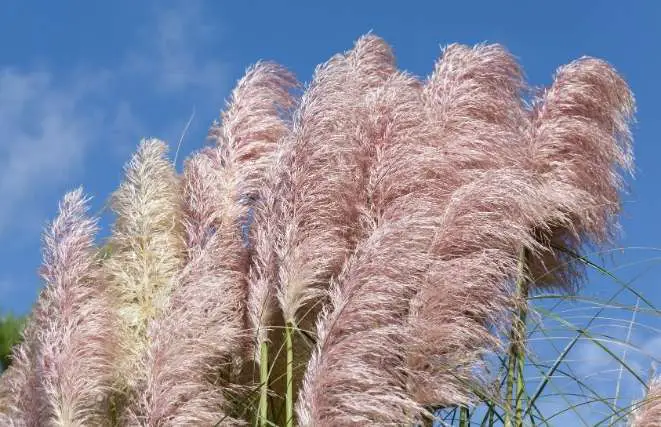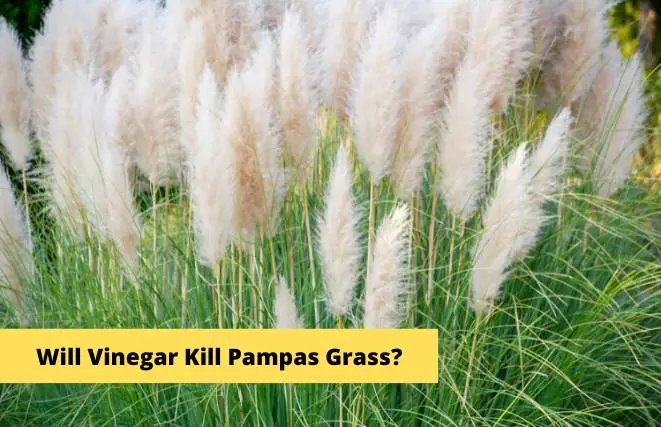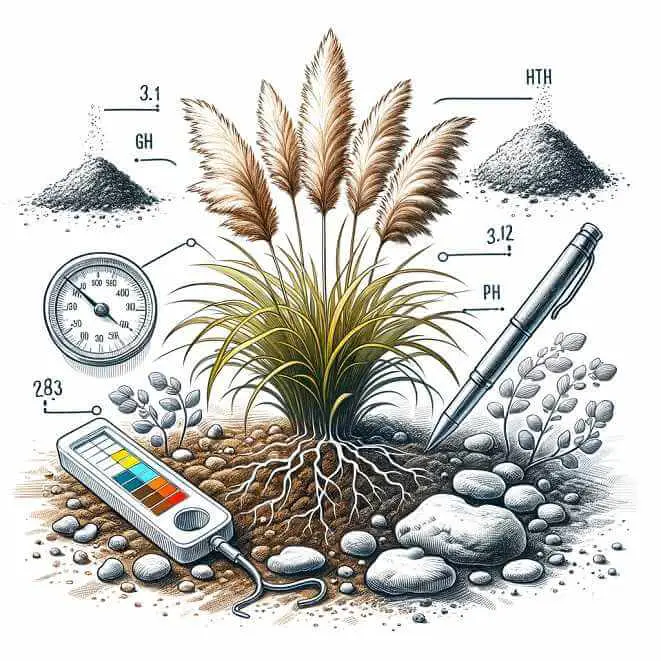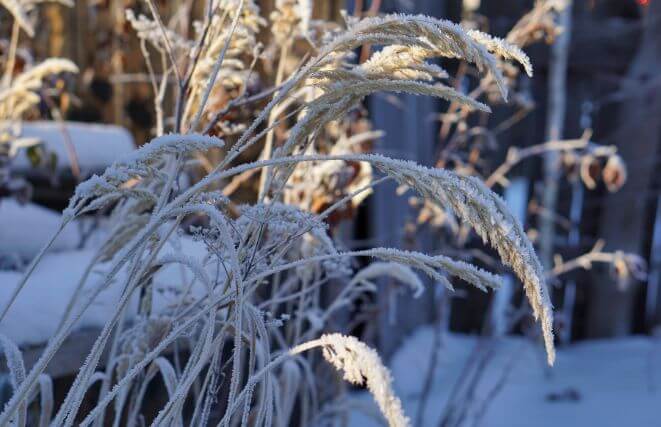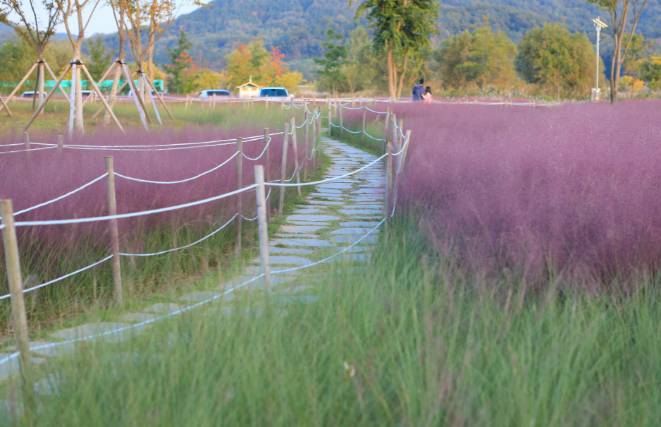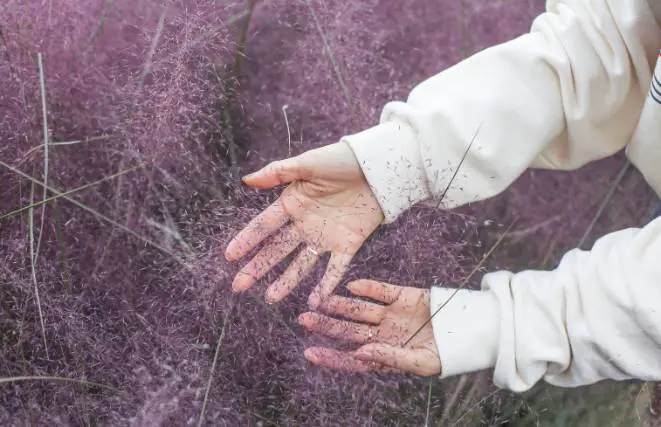Pink Pampas Grass is a variety of Pampas Grass that has pink or pinkish-white fluffy plumes. It is a popular ornamental grass and is often used in landscaping and floral arrangements. Pink Pampas Grass is typically drought-tolerant and low maintenance, making it an ideal choice for gardens and landscapes. It can grow up to 10 feet tall and requires full sun and well-draining soil. Pink pampas grasses are distinct from the more common variety in a few ways. You can learn all about pink pampas grass in this article.
Pink Pampas Grass Cortaderia Selloana
Pampas grass has the botanical name Cortaderia selloana. The pink variety is known as Cortaderia selloana ‘Rosea.’ It is part of a species of flowering plants that are native to South America. It is a smaller plant compared to the more common off-white variety. The full plant can grow to a height of 6 feet and a spread of up to 3 feet. This is in comparison to the taller plant that can grow to a height of 6 feet to 10 feet and a spread of 3 – 6 feet. It is also a more delicate plant than the larger specimens. It is also less hardy and can grow in different USDA zones.
This variety produces large blooms, and the foliage is a deep green color. It is also deer-resistant. The leaves are sharp and tough, so you may need o use gloves when handling them.
| Common Name | Pink Pampas Grass |
| Scientific Name | Cortaderia selloana ‘Rosea’ |
| Height & Spread | 6-10 ft tall and 3-6 ft wide |
| Sun Exposure | Full sun to partial shade |
| USDA Growing Zones | Zones 7-10 |
| Water | Moderate watering |
| Soil Type | Well-drained soil |
| Soil pH | 6.0-7.5 |
| Pests & Diseases | Susceptible to rust and fungal diseases |
| Bloom Time | Late summer to early fall |
| Flower Color | Pink |
| Native Area | South America |
Uses of Pink Pampas Grass
As ornamental grass, Cortaderia selloana ‘Rosea’ can be found in the wild or grown commercially. The pink plumes can be cut and used straight from the plant. Another option is to use pink pampas grass dried. These pampas grass cuts are added to fresh or dry floral arrangements for decoration purposes.
The pink pampas grass plant can be grown to beautify a landscape. It makes an excellent privacy screen because of how tall it can become when it has grown in full. It’s worth noting that the height isn’t as high as the white plume variety. You may find it grown in a cluster in the middle of a lawn or by a pool area.
Growing Information
If you are interested in cultivating pink pampas grass, and you are from a region where you have permission to do this, there are a few considerations you have to make. There are two options to grow this plant. The first option is to start from the seeds. This method takes a lot more time than the other, which is to propagate new plants from the clumps of existing clusters.
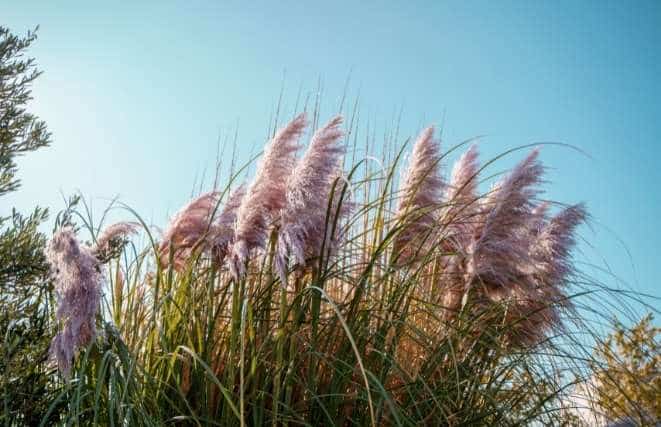
Pink Pampas Grass Zone
Pink pampas grass grows best in USDA Zone 8 and USDA Zone 9. There has been some zone creep with other varieties with some varieties being grown in Zones 7, 6, and even 5. If you are in hardiness Zone 7 or lower and decide to give this plant a chance, you should note that this grass does not do as well in places with very cold or moderate winter temperatures because it likes full sun. Due to this, it does not make a good indoor plant unless you are planning to do this in the winter-time.
You can read more about the topic in my new article: Pampas Grass Zone Insights and More
Optimal Growing Conditions
All in all, pink pampas grass is easy to grow. It is an excellent pick if you need something low maintenance to beautify your garden. There is very little that you have to do to make the growth rate fast. You may choose to add some fertilizer when you propagate or prune the clusters, but this is entirely optional. As a wild variety, these grasses are very resilient and disease-resistant.
This variety grows best in a place with full sun exposure. It can grow in a range of soil types, including normal, sandy, or clay soils. As far a soil pH, it is not very picky and can grow well in acidic, neutral, or alkaline soils. It needs well-drained soil.
The proper planting time for this variety depends on what your starting point is and whether you are in Zones 7, 8, 9, or a different zone. You can get more information on that from your supplier to make sure you do the planting at the right time of the year.
The blooming time is late summer, fall, that is in early fall, mid-fall, or even late fall. You can prune the plant does in late winter or the spring-time. It’s a good idea to do this pruning every spring so that when the summer comes around the next year, the product is healthier and more beautiful blooms.
This species is perennial, which means that the same cluster can grow year-round and continue to bloom every year. Cortaderia selloana ‘Rosea ‘ is very fast-growing and can reach full maturity in 3 years because it is a sizeable plant.
Why Is Pampas Grass Bad?
Despite all the uses of this ornamental grass, it comes with a word of caution. Pink pampas grass Cortaderia jubata can grow very fast. It produces many seeds. Like other plants in the grasses family, these seeds are dispersed by the wind. With one plant producing millions of seeds in the course of its lifetime, there is a huge risk that it may take over an entire area.
Pink pampas grass is therefore invasive. Without proper controls and a way of preventing the seeds from being dispersed and germinating in new areas, the natural ecosystem can be affected. These grasses grow in clumps and form a large and spread-out plant. It can choke out other plants that already grow in the same area and eventually take over a garden. This is a threat to the vegetation and animals growing and living there, and to the biodiversity of the area, as a result.
Due to its invasive potential, pampas grass is illegal in a few places around the world. In other regions, it is classified as a weed. There are also ways to prevent the mass production of seeds in places where it is allowed. There are dwarf varieties that are sterile and do not produce sterile. People can also use products such as herbicides to kill off excessive shoots before they become too large. There is a lot of information available about how to prevent the spread and contain the grasses if you decide to add them to your property for decorative purposes.
How to Remove Pink Pampas Grass?
Removing Pink Pampas Grass (Cortaderia selloana ‘Rosea’) can be a challenging task due to its size and the potential for sharp foliage, but it’s essential to do so properly to prevent regrowth. Here are steps to safely and effectively remove Pink Pampas Grass:
Tools and Materials You’ll Need:
- Thick gardening gloves
- Pruning shears or loppers
- Shovel or spade
- Wheelbarrow or large trash bags
- Tarp or drop cloth (optional)
- Herbicide (optional)
Steps:
- Safety First: Wear thick gardening gloves and protective clothing to avoid contact with the sharp leaves of the Pampas Grass. Safety goggles or glasses can also be beneficial.
- Prune the Foliage: Start by cutting back the foliage of the Pink Pampas Grass. Use pruning shears or loppers to trim the leaves as close to the base as possible. This will make it easier to access the root system.
- Digging Out the Plant:(Manual Removal): If the plant is small or if you prefer a manual approach, use a shovel or spade to dig around the base of the grass. Work your way around the plant, loosening the soil and exposing the root system.
- Remove the Roots: Carefully lift the Pink Pampas Grass out of the ground, ensuring that you remove as much of the root system as possible. The roots can be extensive and challenging to remove entirely.
- Dispose of the Plant: Place the removed plant parts, including the foliage and roots, in a wheelbarrow or large trash bags for disposal. If desired, you can place a tarp or drop cloth on the ground to catch any loose debris during removal.
- Consider Herbicide (Optional): If you’re concerned about regrowth, you can apply a glyphosate-based herbicide to the cut stump immediately after removal. Follow the manufacturer’s instructions for the specific herbicide you choose. This can help prevent new shoots from sprouting.
Remember that Pink Pampas Grass can be challenging to remove completely due to its robust root system, and regrowth can occur if even a small portion of the root is left behind. Regular monitoring of the area and prompt removal of any new growth is essential to prevent it from coming back.
Difference between male and female pink pampas grass?
When it comes to Pink Pampas Grass (Cortaderia selloana), the terms “male” and “female” are often used to refer to different aspects of the plant’s appearance and growth characteristics. However, it’s important to note that Pink Pampas Grass is a dioecious species, which means that individual plants can be either male or female. Here’s a comparison between the male and female plants:
Male Pink Pampas Grass
- Plume Appearance: Male plants typically produce larger and more feathery plumes compared to female plants. These plumes can be quite striking, with a fluffy appearance and a more prominent display.
- Seed Production: Male plants do not produce viable seeds. Instead, their focus is on the development of showy plumes for aesthetic purposes.
- Size: Male Pink Pampas Grass plants can grow to a similar height as the female plants, typically reaching heights of 6 to 10 feet.
Female Pink Pampas Grass
- Plume Appearance: Female plants produce smaller and less showy plumes compared to male plants. The plumes are typically more compact and less fluffy in appearance.
- Seed Production: Female plants are responsible for seed production. They produce seed heads that can become fluffy and white as they mature. These seeds can disperse and potentially lead to the spread of the grass if not controlled.
- Size: Female Pink Pampas Grass plants can grow to a similar height as the male plants, typically reaching heights of 6 to 10 feet.
It’s worth noting that both male and female Pink Pampas Grass plants can be visually appealing in the garden, and the choice between the two may depend on personal preferences and the desired aesthetic effect. However, it’s important to carefully manage and control the spread of the grass, especially if you have female plants that produce seeds, as Pink Pampas Grass can be invasive in some regions.
Where to find seeds and dried plumes?
If you are looking for seeds to cultivate yourself, you can order some stock on Amazon. If you prefer to buy the dry grass pink plumes, you can order stock on Amazon. You get free shipping with Amazon Prime. This product has 30 pieces of 21.65″ plumes and is rated 5 stars. Pink pampas grass, artificial faux pampas grass, are also available. If you prefer to use clusters, you can try a nursery.

There are many products available. You have to make sure that you find high-quality products, and that the seller can ship them to your location, possibly for free.
How to Dry Pink Pampas Grass?
Drying Pink Pampas Grass (Cortaderia selloana ‘Rosea’) can be a wonderful way to preserve its unique and fluffy plumes for decorative purposes. Here’s how you can dry Pink Pampas Grass effectively:
Materials You’ll Need:
- Freshly cut Pink Pampas Grass plumes
- Pruning shears or garden scissors
- Rubber bands or twine
- A dry, well-ventilated area
- An optional preservative spray (such as hairspray)
Steps:
Cut the Grass
- Harvest the Plumes: Choose healthy and mature plumes of Pink Pampas Grass to harvest. Select plumes that are in good condition with no signs of damage or pest infestation. It’s best to harvest the plumes in late summer or early fall when they are at their peak.
- Cut the Plumes: Use pruning shears or garden scissors to cut the plumes from the plant. Make clean cuts as close to the base of the plume as possible. Aim to cut the plumes to your desired length, typically around 2 to 3 feet long or as needed for your decorative purposes.
- Bundle and Secure: Gather several plumes together into a bundle, typically 4 to 6 plumes per bundle. Use rubber bands or twine to secure the base of the plumes tightly. Make sure the bundle is secure to prevent the plumes from separating during drying.
Dry the Grass
- Hang for Drying: Find a dry and well-ventilated area where you can hang the bundles of Pink Pampas Grass upside down. This can be a garage, attic, or any space where the plumes won’t be exposed to moisture. Ensure good air circulation to facilitate drying.
- Wait for Drying: Allow the Pink Pampas Grass bundles to air dry for several weeks to a few months. The drying time can vary depending on humidity levels and the thickness of the plumes. You’ll know they are fully dry when they feel crisp and no longer contain moisture.
Spray the Grass
- Optional Preservative Spray: If you want to enhance the longevity of your dried Pink Pampas Grass and reduce shedding, you can use a preservative spray like hairspray. Hold the spray about 12 inches away from the plumes and lightly coat them. Let the plumes dry completely before handling.
- Arrange and Display: Once the Pink Pampas Grass plumes are fully dried and treated (if desired), you can arrange them in vases, use them for wreaths, or incorporate them into various decorative projects. They make stunning additions to floral arrangements and home decor.
Dried Pink Pampas Grass plumes can add a touch of elegance and texture to your interior decor, and they retain their unique appearance for an extended period when properly dried and preserved.
MORE: How to Dry Pampas Grass: A Step-by-Step Guide
Is pink pampas grass invasive?
Pink pampas grass (Cortaderia jubata) is considered invasive in many regions. It has a similar appearance to white pampas grass (Cortaderia selloana) but is more aggressive in its growth habits. Pink pampas grass has the potential to spread rapidly and outcompete native plant species, leading to negative impacts on local ecosystems. It can produce copious amounts of seeds that are easily dispersed by wind, further contributing to its invasiveness. Due to its invasiveness, pink pampas grass is often regulated or banned in certain areas to prevent its spread. It is essential to check with local authorities or consult invasive species lists to determine if pink pampas grass is a concern in your specific region before considering its cultivation.
Pink Pampas Grass Alternative
If you’re looking for alternatives to Pink Pampas Grass (Cortaderia selloana) for your garden, here are some options that can provide similar visual interest and texture:
- Feather Reed Grass (Calamagrostis acutiflora): This cool-season grass features upright clumps of narrow, feathery, and arching green foliage. It produces tall, slender flower spikes in summer that turn golden or tan as they mature. Varieties like ‘Karl Foerster’ and ‘Overdam’ are popular choices.
- Maiden Grass (Miscanthus sinensis): Maiden Grass is a popular ornamental grass with graceful, arching foliage. It comes in a variety of cultivars, such as ‘Gracillimus’ with narrow green leaves, ‘Morning Light’ with variegated foliage, or ‘Strictus’ with distinctive horizontal banding on the leaves. They produce showy plumes in late summer or fall.
- Fountain Grass (Pennisetum alopecuroides): This warm-season grass forms neat mounds of arching foliage and produces fluffy, bottlebrush-like flower spikes. The cultivar ‘Hameln’ is a compact variety that reaches about 2 to 3 feet in height, while ‘Little Bunny’ is even smaller, making it suitable for smaller gardens or containers.
- Switchgrass (Panicum virgatum): Switchgrass is a native warm-season grass that offers a range of cultivars with different heights and foliage colors. It has a strong vertical habit and produces airy, open flower panicles in late summer that transition to attractive seed heads in fall. Cultivars like ‘Shenandoah’ and ‘Heavy Metal’ are popular choices.
- Blue Oat Grass (Helictotrichon sempervirens): Blue Oat Grass is a cool-season grass that forms dense clumps of blue-gray, needle-like foliage. It provides a striking contrast in color and texture.
These are just a few examples of ornamental grasses that can serve as alternatives to Pink Pampas Grass. Consider their growth habit, size, and compatibility with your garden’s conditions to choose the most suitable option for your landscape design.
People also ask
Yes. Pink pampas grass is a type of ornamental grass that has been cultivated and grown in gardens for centuries. It is native to Argentina and Uruguay, but it can grow in many different climates.
The pink color of the blades comes from the chlorophyll that they have, which is not common to other types of grasses. The blades are also softer than other types of grasses.
Pink pampas grass grows best in regions with mild winters and warm summers. It does not tolerate frost or cold temperatures, so it should be planted in a region that has at least six months of warm weather.
In the US, it is grown in Florida and Texas. Pink pampas grass prefers wet soil and likes to grow near water bodies like rivers or ponds.
The bottom line
The bottom line is the ornamental grasses like pink pampas grass have many good uses. You can cultivate them in your own garden from seeds or clusters, and there are many products available online or from a nursery near you. The full plant can be the highlight of your garden. You can also use the dried product in your floral arrangements.

